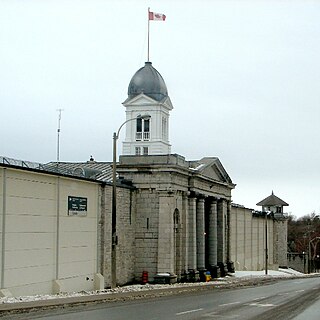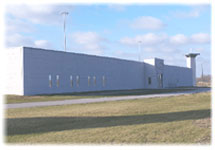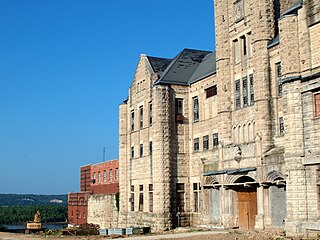
Robert Franklin Stroud, known as the "Birdman of Alcatraz", was a convicted murderer, American federal prisoner and author who has been cited as one of the most notorious criminals in the United States. During his time at Leavenworth Penitentiary, he reared and sold birds and became a respected ornithologist. From 1942 to 1959, he was incarcerated at Alcatraz, where regulations did not allow him to keep birds. Stroud was never released from the federal prison system; he was imprisoned from 1909 to his death in 1963.

The panopticon is a design of institutional building with an inbuilt system of control, originated by the English philosopher and social theorist Jeremy Bentham in the 18th century. The concept is to allow all prisoners of an institution to be observed by a single corrections officer, without the inmates knowing whether or not they are being watched.

Kingston Penitentiary is a former maximum security prison located in Kingston, Ontario, Canada, between King Street West and Lake Ontario.

HM Prison Pentonville is an English Category B men's prison, operated by His Majesty's Prison Service. Pentonville Prison is not in Pentonville, but is located further north, on the Caledonian Road in the Barnsbury area of the London Borough of Islington, north London. In 2015 the justice secretary, Michael Gove, described Pentonville as "the most dramatic example of failure" within the prisons estate.

Pelican Bay State Prison (PBSP) is a supermax prison facility in Crescent City, California. The 275-acre (111 ha) prison takes its name from a shallow bay on the Pacific coast, about 2 mi (3.2 km) to the west.

The Eastern State Penitentiary (ESP) is a former American prison in Philadelphia, Pennsylvania. It is located in the Fairmount section of the city, and was operational from 1829 until 1971. The penitentiary refined the revolutionary system of separate incarceration, first pioneered at the Walnut Street Jail, which emphasized principles of reform rather than punishment.

A super-maximum security (supermax) or administrative maximum (ADX) prison is a "control-unit" prison, or a unit within prisons, which represents the most secure level of custody in the prison systems of certain countries.

Millbank Prison or Millbank Penitentiary was a prison in Millbank, Westminster, London, originally constructed as the National Penitentiary, and which for part of its history served as a holding facility for convicted prisoners before they were transported to Australia. It was opened in 1816 and closed in 1890.

Menard Correctional Center, known prior to 1970 as Southern Illinois Penitentiary, is an Illinois state prison located in the town of Chester in Randolph County, Illinois. It houses maximum-security and high-medium-security adult males. The average daily population as of 2007 was 3,410.

The Federal Correctional Complex, Terre Haute is a United States federal prison complex for male inmates in Indiana; much of the complex grounds is in Terre Haute, though portions are in unincorporated Vigo County. It is operated by the Federal Bureau of Prisons, a division of the United States Department of Justice, and consists of two facilities:

A prison, also known as a jail, gaol, penitentiary, detention center, correction center, correctional facility, or remand center, is a facility where people are confined against their will and denied a variety of freedoms under the authority of the state, generally as punishment for various crimes. Authorities most commonly use prisons within a criminal-justice system: people charged with crimes may be imprisoned until their trial; those who have pled or been found guilty of crimes at trial may be sentenced to a specified period of imprisonment.

The Missouri State Penitentiary was a prison in Jefferson City, Missouri, that operated from 1836 to 2004. Part of the Missouri Department of Corrections, it served as the state of Missouri's primary maximum security institution. Before it closed, it was the oldest operating penal facility west of the Mississippi River. It was replaced by the Jefferson City Correctional Center, which opened on September 15, 2004.

The Richmond General Penitentiary was a prison established in 1820 in Grangegorman, Dublin, Ireland as an alternative to transportation. It was part of an experiment into a penitentiary system which also involved Millbank Penitentiary, London. Richmond and Millbank penitentiaries were the first prisons in the United Kingdom of Great Britain and Ireland to specialise in reform rather than punishment. The building was designed by the architect Francis Johnston and decorated by George Stapleton. The building ceased to be a penitentiary in 1831, and later became part of the Richmond Asylum.
Colorado State Penitentiary is a Level V maximum security prison in the U.S. state of Colorado. The facility is part of the state's East Cañon Complex, together with six other state correctional facilities of various security levels.

A prisoner is a person who is deprived of liberty against their will. This can be by confinement or captivity in a prison, or forcible restraint. The term usually applies to one serving a sentence in prison.
The British Columbia Penitentiary was a federal maximum security prison located in New Westminster, British Columbia, Canada. The BC Penitentiary operated for 102 years, from 1878 until it was decommissioned in 1980. It was the first federal penal institution west of Manitoba. The Gatehouse was sold on September 8,2021 and was renamed Governors Castle by new owners. Colliers international Appraised the Building at $8,950,000, additional open space for $4,500,00, totalling $13,450,000 at time of purchase by Governors Court Inc.

United States Penitentiary, Alcatraz Island, also known simply as Alcatraz or The Rock, was a maximum security federal prison on Alcatraz Island, 1.25 miles (2.01 km) off the coast of San Francisco, California, United States. The site of a fort since the 1850s, the main prison building was built in 1910–12 as a U.S. Army military prison.

Rufe Persful was an American criminal, convicted of murder, kidnapping and robbery. He was considered one of the most dangerous criminals of his era by the authorities.

Imprisonment began to replace other forms of criminal punishment in the United States just before the American Revolution, though penal incarceration efforts had been ongoing in England since as early as the 1500s, and prisons in the form of dungeons and various detention facilities had existed as early as the first sovereign states. In colonial times, courts and magistrates would impose punishments including fines, forced labor, public restraint, flogging, maiming, and death, with sheriffs detaining some defendants awaiting trial. The use of confinement as a punishment in itself was originally seen as a more humane alternative to capital and corporal punishment, especially among Quakers in Pennsylvania. Prison building efforts in the United States came in three major waves. The first began during the Jacksonian Era and led to the widespread use of imprisonment and rehabilitative labor as the primary penalty for most crimes in nearly all states by the time of the American Civil War. The second began after the Civil War and gained momentum during the Progressive Era, bringing a number of new mechanisms—such as parole, probation, and indeterminate sentencing—into the mainstream of American penal practice. Finally, since the early 1970s, the United States has engaged in a historically unprecedented expansion of its imprisonment systems at both the federal and state level. Since 1973, the number of incarcerated persons in the United States has increased five-fold. Now, about 2,200,000 people, or 3.2 percent of the adult population, are imprisoned in the United States, and about 7,000,000 are under supervision of some form in the correctional system, including parole and probation. Periods of prison construction and reform produced major changes in the structure of prison systems and their missions, the responsibilities of federal and state agencies for administering and supervising them, as well as the legal and political status of prisoners themselves.
Prisoners' Justice Day is a solidarity movement that takes place annually on August 10. The movement began in Canada in 1974 in support of prisoners’ rights and to remember all the people who have died of unnatural deaths while incarcerated. The first Prisoners' Justice Day was held at the Millhaven Institution on August 10, 1975, on the first anniversary of Edward Nalon's death. In addition to a day of mourning, six prisoners took part in an eighteen-day hunger strike. In 1976, August 10 was recognized as a memorial day where prisoners would strike in opposition to the use of solitary confinement and to protest inmate conditions within the Prison System by going on a one-day hunger strike and refusing to work.


















